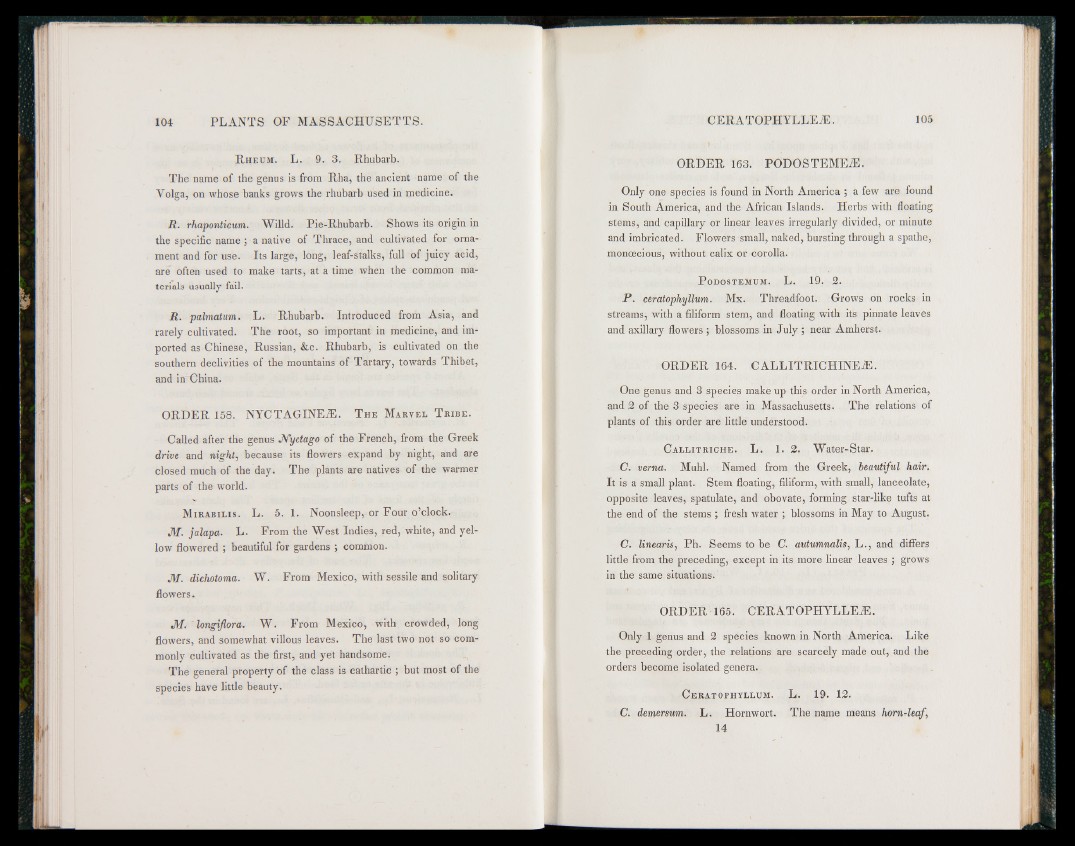
R heum. L. 9. 3» Rhubarb.
The name of the genus is from Rha, the ancient name of the
Volga, on whose banks grows the rhubarb used in medicine.
R. rhaponticum. Willd. Pie-Rhubarb. Shows its origin in
the specific name; a native of Thrace, and cultivated for ornament
and for use. Its large, long, leaf-stalks, full of juicy acid,
are often used to make tarts, at a time when the common materials
usually fail.
R. palmatum. L. Rhubarb. Introduced from Asia, and
rarely cultivated. The root, so important in medicine, and imported
as Chinese, Russian, &c. Rhubarb, is cultivated on the
southern declivities of the mountains of Tartary, towards Thibet,
and in China.
ORDER 158. NYCTAGINEiE. T he Marvel T r ib e .
Called after the genus Nyctago of the French, from the Greek
drive and night, because its flowers expand by night, and are
closed much of the day. The plants are natives of the warmer
parts of the world.
Mira b il is . L. 5. 1. Noonsleep, or Four o’clock.
M. jalapa. L. From the West Indies, red, white, and yellow
flowered ; beautiful for gardens ; common.
M. dichotoma. W. From Mexico, with sessile and solitary
flowers.
M . ' longiflora. W. From Mexico, with crowded, long
flowers, and somewhat villous leaves. The last two not so commonly
cultivated as the first, and yet handsome.
The general property of the class is cathartic ; but most of the
species have little beauty.
ORDER 163. PODOSTEMEiE.
Only one species is found in North America ; a few are found
in South America, and the African Islands. Herbs with floating
stems, and capillary or linear leaves irregularly divided, or minute
and imbricated. Flowers small, naked, bursting through a spathe,
monoecious, without calix or corolla.
P odostemum. L. 19. 2.
P . ceratophyllum. Mx. Threadfoot. Grows on rocks in
streams, with a filiform stem, and floating with its pinnate leaves
and axillary flowers ; blossoms in July ; near Amherst.
ORDER 164. C A L L ITRICH IN E iE .
One genus and 3 species make up this order in North America,
and 2 of the 3 species are in Massachusetts. The relations of
plants of this order are little understood.
C a l l it r ic h e . L. 1. 2. Water-Star.
C. verna. Muhl. Named from the Greek, beautiful hair.
It is a small plant. Stem floating, filiform, with small, lanceolate,
opposite leaves, spatulate, and obovate, forming star-like tufts at
the end of the stems ; fresh water ; blossoms in May to August.
C. linearis, Ph. Seems to be C. autumnalis, L ., and differs
little from the preceding, except in its more linear leaves ; grows
in the same situations.
ORDER 165. CERA TO PH YLLEiE.
Only 1 genus and 2 species known in North America. Like
the preceding order, the relations are scarcely made out, and the
orders become isolated genera.
C eratophyllum. L. 19. 12,
C. demersum, L. Hornwort. The name means horn-leaf,
14